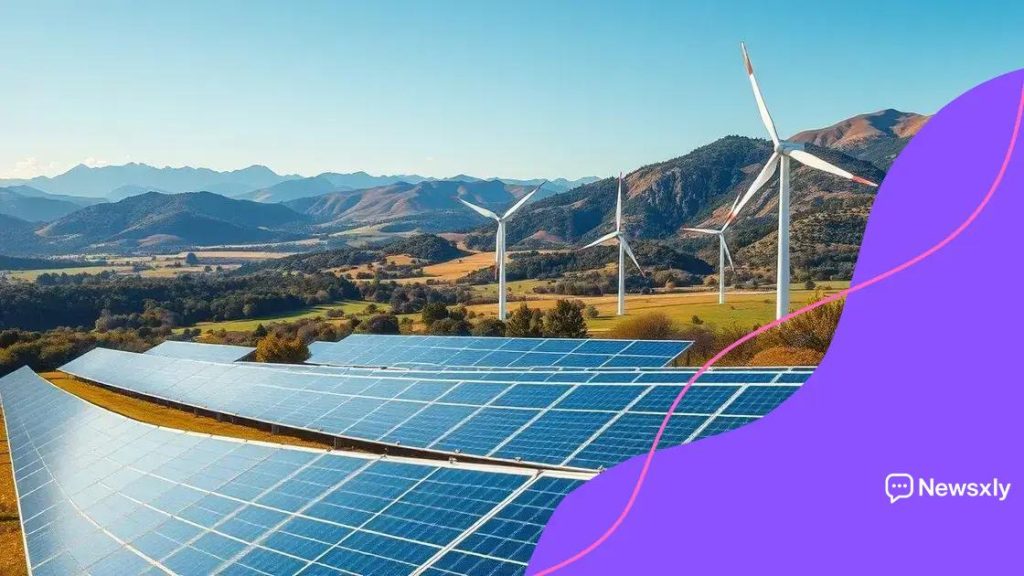Developments in renewable energy technology: what to expect next

Developments in renewable energy technology focus on innovations such as improved solar panels, integration of artificial intelligence, decentralized energy systems, and the emergence of green hydrogen to create a more sustainable energy future.
Developments in renewable energy technology are not just buzzwords; they’re vital to our sustainable future. Have you noticed how these innovations are slowly transforming our energy sources? Let’s dive into the latest breakthroughs together!
Understanding renewable energy technology
Understanding renewable energy technology is crucial for adapting to the ever-changing energy landscape. It includes various forms of energy harnessed from natural sources that are continually replenished. Let’s explore these technologies and the way they are changing our world.
What is Renewable Energy?
Renewable energy comes from sources that are naturally replenished. This can include sunlight, wind, rain, tides, waves, and geothermal heat. Each source has unique features and advantages that contribute to a more sustainable future.
Types of Renewable Energy Technologies
- Solar Energy: Utilizing sunlight to generate electricity through solar panels.
- Wind Energy: Capturing wind flow using turbine technology to produce energy.
- Hydropower: Generating energy from flowing water, usually via dams.
- Biomass: Using organic materials to produce energy, either through combustion or conversion into biofuels.
Each of these technologies plays a significant role in decreasing our reliance on fossil fuels. For example, solar energy has grown exponentially over the past decade, offering a clean and sustainable alternative to electricity generation.
Moreover, advancements in technology have made these systems more efficient and accessible. Innovations embrace better materials, improved energy storage solutions, and smarter grid integrations. These enhancements will help communities today save money and better manage their energy resources.
Benefits of Renewable Energy
The transition to renewable energy technologies brings several key benefits. It reduces greenhouse gas emissions, enhances energy security, creates jobs, and drives innovation. These advantages underscore the need for investment and support from both governments and the private sector.
Investing in renewable energy not only contributes to environmental sustainability but also builds a resilient economy that can thrive in the long term. As we continue to innovate and embrace these technologies, the future looks promising, making it necessary to stay informed about ongoing developments.
Latest advancements in solar energy
The latest advancements in solar energy reflect a growing commitment to sustainable energy solutions. As technology evolves, the efficiency and affordability of solar power continue to improve. This progress allows more households and businesses to benefit from clean energy.
Improved Solar Panel Efficiency
Recent innovations have led to solar panels that convert a greater percentage of sunlight into electricity. For instance, new materials like perovskite have shown incredible promise, potentially surpassing the efficiency of traditional silicon-based panels.
Flexible and Lightweight Solar Solutions
Another exciting development is the creation of flexible and lightweight solar panels. These panels can be integrated into various surfaces, including windows and vehicles. Their adaptability means they can harness solar energy in places previously thought impractical.
- Building-integrated photovoltaics: Solar materials embedded directly into buildings.
- Solar skins: Customizable designs to match a home’s aesthetic.
- Portable solar chargers: Convenient energy solutions for on-the-go power needs.
The integration of solar energy into more everyday products opens up new possibilities. With technological advancements, homeowners can now enjoy both aesthetics and functionality in their energy systems. This evolution is essential for promoting wider adoption of solar energy.
Energy Storage Improvements
Improvements in energy storage technology are also crucial. Advanced battery systems allow excess energy generated during sunny days to be stored for later use. This capability enhances the reliability of solar energy, making it a more attractive option for consumers.
Overall, the developments in solar energy technology are revolutionizing how we harness and use energy. With cleaner, more efficient solutions, we move closer to a sustainable future.
Innovations in wind power generation

Innovations in wind power generation are paving the way for cleaner and more sustainable energy solutions. As technology advances, the efficiency and effectiveness of wind energy systems continue to improve, making them a vital part of the global energy mix.
Advanced Turbine Designs
One of the most significant developments in this field is the creation of larger and more efficient wind turbines. These new designs can capture more wind energy and convert it into electricity. Innovations like vertical-axis wind turbines are gaining traction, as they can function in varied wind conditions and take up less space.
Offshore Wind Farms
Another exciting trend is the growth of offshore wind farms. These installations harness the powerful winds available over the ocean. Using advanced technology, offshore wind turbines can generate substantial amounts of energy while minimizing land use. The distance from land also reduces noise and visual impact, making wind energy more appealing.
- Floating wind farms: Innovative designs allow turbines to be installed in deeper water.
- Smart grid technology: Enhances management of wind energy supply.
- Energy storage solutions: Helps balance wind energy availability and demand.
These advancements not only increase the amount of renewable energy we can generate but also help to ensure that it is accessible and usable when needed. By enhancing energy storage and incorporating smart technology, the wind energy sector is becoming more reliable and integral to our energy systems.
Environmental Benefits
Choosing wind power has significant environmental benefits. It produces zero emissions during operation, contributing to cleaner air and a reduction in greenhouse gases. Innovations in wind energy also promote biodiversity by utilizing land effectively and protecting ecosystems.
As winds of change continue to blow in this sector, changing how we produce energy, it’s essential to stay informed and support advancements in wind power generation. These developments are crucial for achieving a sustainable energy future.
Challenges facing renewable energy adoption
The challenges facing renewable energy adoption are significant but not insurmountable. As we push towards a more sustainable future, understanding these obstacles helps in finding effective solutions. One major hurdle is the initial cost of renewable energy systems, which can deter potential users.
Initial Investment and Financing
Many renewable technologies require a substantial upfront investment. Although the long-term savings can be impressive, the high cost can discourage homeowners and businesses from making the switch. To overcome this, the availability of financing options, subsidies, and incentives can motivate adoption.
Infrastructure Limitations
Another significant challenge is the lack of infrastructure to support renewable energy systems. In many areas, power grids are outdated and not designed to handle the decentralized energy generation that renewables often require. Upgrading and expanding infrastructure is essential for effectively integrating renewable sources.
- Grid stability: Maintaining a stable grid when incorporating variable renewable energy sources is complex.
- Energy storage: Developing efficient storage solutions is crucial to balance supply and demand.
- Policy support: Laws and regulations must evolve to favor renewable energy integration.
Furthermore, public perception plays a vital role in the acceptance of renewable energy. Some people remain skeptical, primarily due to misinformation or a lack of understanding of how these technologies work. Educational campaigns that provide accurate information can help change these views.
Environmental and Social Factors
There are also environmental concerns, such as the impact of large-scale wind farms on local wildlife. Balancing development with ecological preservation is crucial. Social factors, including local resistance to installation sites, can also impede progress. Engaging communities in the planning process often leads to better outcomes.
While the challenges facing renewable energy adoption may seem daunting, they also present opportunities for innovation and collaboration. As technology improves and awareness grows, solutions will emerge, paving the way for a cleaner, more sustainable future.
Future trends in renewable energy technology
Future trends in renewable energy technology are shaping a more sustainable world, running parallel with innovations that enhance efficiency and accessibility. As we look ahead, several key developments are expected to transform the energy landscape.
Integration of Artificial Intelligence
One of the most exciting trends is the integration of artificial intelligence (AI) into energy systems. AI can optimize energy production by predicting demand and monitoring performance. These advanced systems enhance the efficiency of renewable energy technologies, making them more reliable and user-friendly.
Decentralized Energy Systems
Decentralized energy systems are also on the rise. Instead of relying solely on large power plants, communities are increasingly adopting local energy solutions. This includes solar panels on rooftops and small wind turbines that provide power directly to homes. Such systems empower consumers and reduce transmission losses.
- Microgrids: Local energy networks that can operate independently and reduce reliance on central grids.
- Community solar projects: Shared solar installations that allow multiple households to benefit from one solar array.
- Energy-as-a-Service: Subscription models enabling consumers to pay for energy usage without installing systems.
Additionally, advancements in battery storage technology are critical to extending the use of renewable energy. Improved batteries can store energy generated during peak production times, such as sunny afternoons or windy nights, and release it when demand is high. Enhanced storage capacity not only stabilizes energy supply but also boosts the attractiveness of renewable options.
Transition to Green Hydrogen
Another major trend is the shift toward green hydrogen as a clean energy carrier. Produced from renewable energy sources, green hydrogen has the potential to power vehicles and provide energy storage solutions. Its versatility makes it a powerful tool in reducing carbon emissions and facilitating the transition to a renewable energy economy.
As we evolve our energy practices, the emphasis on sustainability will continue to grow. These future trends in renewable energy technology not only promise to make energy cleaner but also more accessible, driving global efforts toward a greener future.
FAQ – Frequently Asked Questions about Renewable Energy Technology
What are the key benefits of renewable energy?
Renewable energy reduces greenhouse gas emissions, enhances energy security, and often leads to lower energy costs in the long run.
How does solar energy work?
Solar energy works by converting sunlight into electricity using solar panels, which can be installed on rooftops or in solar farms.
What is green hydrogen and why is it important?
Green hydrogen is produced using renewable energy and can be used as a clean fuel source, making it crucial for reducing carbon emissions.
What challenges do we face in adopting renewable energy?
Challenges include high upfront costs, lack of infrastructure, and public misconceptions about renewable technologies.





